Physical activity can help people live longer and lower their risk for heart disease, stroke, type 2 diabetes, depression and certain cancers, according to the Centers for Disease Control (CDC). Some studies even suggest exercise can help prevent or slow the onset of dementia.
The benefits of exercise are clear. However, if you’re planning to start a new exercise routine, first check with your doctor to make sure you have no underlying health issues. Then use these four tips to exercise safely and get the most from your regimen.
Slow down and warm up
“Warming up helps loosen your muscles and joints,” says Dr. Joshua Harris, orthopedic surgeon at Houston Methodist. “A proper warmup may consist simply of walking 5-10 minutes. Vigorous stretching should be avoided, as the muscles and tendons are not yet ‘warm’ and may increase injury risk.” When beginning a walking, biking, swimming or running regimen, it’s important to start slowly — perhaps limiting yourself to as few as 10 minutes a day. Gradually increase speed and distance over time to reach a pace that’s appropriate for your age, physical condition and fitness goals.
“If you exercise by playing golf or tennis, it’s especially important to warm up the muscles involved in the unique motions common to those sports,” Dr. Harris says.
Don’t skip the cool down
After exercising, it’s important to cool down and gradually return your heart rate to normal. This may include walking, light calisthenics or gentle stretching. Again, as with the warmup, vigorous stretching should be avoided.
Try cross-training
Cross-training simply means varying your exercise routine. A typical schedule may include:
Day 1: Aerobic activity like walking, running, biking or swimming to promote heart and lung function
Day 2: Weight lifting to strengthen muscles and bones
Day 3: Yoga, tai chi or activities as simple as stretching and standing on one foot develop flexibility and balance
“By varying your routine, you reduce the risk of a variety of overuse injuries, including muscle strains, tendonitis and stress fractures, among several others,” says Dr. Harris, who also serves as a team physician for the Houston Ballet, team orthopedist for the Houston Dynamo and consulting orthopedist for Rice University Athletics. “It also can promote better all-around fitness.”
Don’t overdo it
It’s common to experience achy muscles for a day or two after exercise, especially when starting a new routine or increasing intensity. However, it’s important to stop what you’re doing if you experience pain. If the pain is severe, or it continues beyond a couple of days, see your doctor right away.
Whether you are new to a workout program or have been doing it for decades, the best advice is to listen to your body. If you have pain that persists for several days that prevents you from performing simple activities of daily living or returning back to your exercise program, then you likely either need to reduce the intensity of the program or see a doctor.


